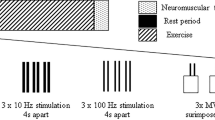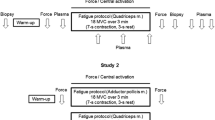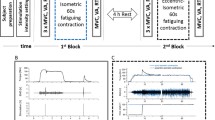Summary
Repetitive static exercise (RSE) is a repetitive condition of partial ischaemia/reperfusion and may therefore be connected to the formation of oxygen-derived free radicals and tissue damage. Seven subjects performed two-legged intermittent knee extension exercise repeating at 10 s on and 10 s off at a target force corresponding to about 30% of the maximal voluntary contraction force. The RSE was continued for 80 min (n=4) or to fatigue (n=3). Four of the subjects also performed submaximal dynamic exercise (DE) at. an intensity of about 60% maximal oxygen uptake (VO2max) for the same period. Whole body oxygen uptake (VO2) increased gradually with time during RSE (P<0.05), indicating a decreased mechanical efficiency. This was further supported by a slow increase in leg blood flow (P<0.05) and leg oxygen utilization (n.s.) during RSE. In contrast, prolonged RSE had no effect onVO2 during submaximal cycling. Maximal force (measured in six additional subjects) declined gradually during RSE and was not completely restored after 60 min of recovery. After 20 and 80 min (or at fatigue) RSE phosphocreatine (PC) dropped to 74% and 60% of the initial value, respectively. A similar decrease in PC occurred during DE. Muscle and arterial lactate concentrations remained low during both RSE and DE. The three subjects who were unable to continue RSE for 80 min showed no signs of a more severe energy imbalance than the other subjects. A continuous release of K+ occurred during both RSE and DE. The total muscle loss of K+ was about 3% and 6% of the total muscle K+ content during RSE and DE, respectively. Muscle glutathione, glutathione disulphide, ubiquinone and α-tocopherol are involved in the cellular defence system against free radicals. During RSE and DE these parameters were unchanged and plasma malondialdehyde (a product of free radical induced lipid peroxidation) remained below the detection limit. In conclusion, prolonged RSE resulted in a gradual decrease in PC, mechanical efficiency and maximal force. There were no signs of an enhanced rate of free radical formation.
Similar content being viewed by others
References
Andersson ME (1985) Determination of glutathione and glutatione disulfide in biological samples. Methods Enzymol 113:548–555
Bergmeyer HU (1974) Methods of enzymatic analysis. Verlag Chemie, Weinheim
Bergström J (1962) Muscle electrolytes in man. Scand J Clin Lab Invest [Suppl 68] 14:1–110
Corbucci GG, Montanari G, Cooper MB, Jones DA, Edwards RHT (1984) The effect of exertion on mitochondrial oxidative capacity and on some antioxidant mechanisms in muscle from marathon runners. Int J Sports Med 5:135
Davis KJA, Quintanilha AT, Brooks GA, Packer L (1982) Free radicals and tissue damage produced by exercise. Biochem Biophys Res Commun 107:1198–1205
Edwards RHT (1988) Hypotheses of peripheral and central mechanisms underlying occupational muscle pain and injury. Eur J Appl Physiol 57:275–281
Edwards RHT, Hill DK, Jones DA (1975) Metabolic changes associated with the slowing of relaxation in fatigued mouse muscle. J Physiol (Lond) 251:287–301
Hikida RS, Staron RS, Hagerman FC, Leonardi M, Gilders R, Falkel J, Murray T, Appell K (1991) Serum creatine kinase activity and its changes after a muscle biopsy. Clin Physiol 11:51–59
Hultman E, Spriet L (1986) Skeletal muscle metabolism, contraction force and glycogen utilization during prolonged electrical stimulation in humans. J Physiol 374:493–501
Jorfeldt L, Wahren J (1971) Leg blood flow during exercise in man. Clin Sci 41:459–473
Korthuis RJ, Grisham MB, Granger DN (1988) Leukocyte depletion attenuates vascular injury in postischemic skeletal muscle. Am J Physiol 254:823–827
Kushmeric MJ (1983) Pattern of chemical energetics in fast- and slow-twitch mammalian muscles. In: Knuttgen HG, Vogel JA, Poortmans J (eds) Biochemistry of exercise, vol. 13. Human Kinetics, Champaign, Ill., pp 50–62
Lang JK, Packer L (1987) Quantitative determination of vitamin E and oxidized and reduced coenzyme Q by electrochemical detection. J Chromatogr 385:109–117
Largilliere C, Mélancon SB (1988) Free malondialdehyde determination in human plasma by high-performance liquid chromatography. Anal Biochem 170:123–126
McCord JM (1985) Oxygen-derived free radicals in postischemic tissue injury. N Engl J Med 312:159–163
Packer L (1987) Exercise, aging and antioxidants. In: Benzi G (ed) Advances in myochemistry. Libbey, London, pp 37–50
Nilsson L H:son (1973) Liver glycogen content in man in the postabsorptive state. Scand J Clin Lab Invest 32:317–323
Sahlin K (1983) NADH and NADPH in human skeletal muscle at rest and during ischaemia. Clin Physiol 3:477–485
Sahlin K, Ren JM (1989) Relationship of contraction capacity to metabolic changes during recovery from a fatiguing contraction. J Appl Physiol 67:648–654
Sahlin K, Broberg S (1990) Adenine nucleotide depletion in human muscle during exercise: causality and signcance of AMP deamination. Int J Sports Med [Suppl 2]:862–867
Sahlin K, Ekberg K, Cizinsky S (1991) Changes in plasma hypoxanthin and free radical markers during exercise in man. Acta Physiol Scand 142:275–281
Schweinsberg PD, Loo TL (1980) Simultaneous analysis of ATP, ADP, AMP and other purines in human erythrocytes by HPLC. J Chromatogr 181:103–107
Sjøgaard G, Savard G, Juel C (1988) Muscle blood flow during isometric activity and its relation to muscle fatigue. Eur J Appl Physiol 57:327–335
Smith JK, Carden DL, Grisham MB, Granger DN, Korthuis RJ (1989) Role of iron in postischemic microvascular injury. Am J Physiol 256:1472–1477
Sargeant AJ, Dolan P (1987) Human muscle function following prolonged eccentric exercise. Eur J Appl Physiol 56:704–711
Saugen E, Vollestad NK (1991) Increased muscle heat production during repetitive isometric contraction. Acta Physiol Scand 143:P15
Svensson G, Anfält T (1982) Rapid determination of ammonia in whole blood and plasma using flow injection analysis. Clin Chim Acta 119:7–14
Vøllestad NK, Sejersted OM, Bahr R, Woods JJ, Bigland-Ritchie B (1988) Motor drive and metabolic responses during repeated submaximal contraction in humans. J Appl Physiol 64:1421–1427
Vøllestad NK, Wesche J, Sejersted OM (1990) Gradual increase in leg oxygen uptake during repeated submaximal contractions in humans. J Appl Physiol 68:1150–1156
Wajner M, Harkness RA (1988) Distribution of xanthine dehydrogenase and oxidase activities in human and rabbit tissues. Biochem Soc Trans 16:358–359
Wung WE, Howell SB (1980) Simultaneous liquid chromatography of 5-fluorouracil, uridine, hypoxanthine, xanthine, uric acid, allopurinol, and oxipurinol in plasma. Clin Chem 26:1704–1708
Ytrehus K, Reikers O, Mjs OD (1988) Reduced levels of high energy phosphate in reperfused dog gracilis muscle, partly due to oxygen radicals. Acta Physiol Scand 134 [Suppl 575]:C34
Author information
Authors and Affiliations
Rights and permissions
About this article
Cite this article
Sahlin, K., Cizinsky, S., Warholm, M. et al. Repetitive static muscle contractions in humans —a trigger of metabolic and oxidative stress?. Europ. J. Appl. Physiol. 64, 228–236 (1992). https://doi.org/10.1007/BF00626285
Accepted:
Issue Date:
DOI: https://doi.org/10.1007/BF00626285




